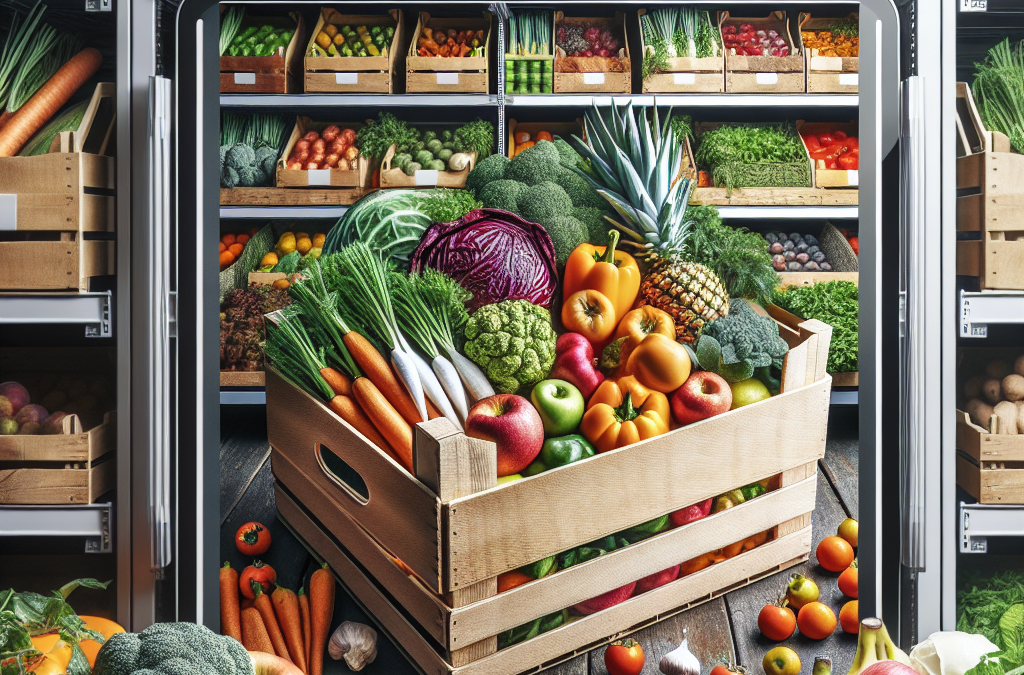Understanding Organic Produce
What Makes Produce Organic?
Let’s start by chatting about what organic really means. In my journey, I’ve come to realize that organic produce comes from farms that utilize sustainable farming practices. No synthetic fertilizers or pesticides, just good ol’ nature at work! It’s fascinating to support farmers who prioritize the health of our environment.
When I buy organic, I feel like I’m voting with my dollar—a strong way to show support for sustainable farming. The taste is usually better too! You can really tell the difference in flavor when it’s picked at the peak of ripeness and grown with care.
Remember, though, that organic doesn’t mean impervious to spoilage. These beauties can be just as tender as they are tasty, which brings us to the next step—understanding how to store them properly!
The Challenges of Storing Organic Produce
Now let’s chat about the challenges we face with organic produce. Since these items are often fresher and more sensitive, they tend to spoil quicker. I’ve had my fair share of sad, mushy tomatoes because I didn’t treat them right! It’s a bummer, but with the right knowledge, I’ve learned to nip that in the bud.
Humidity plays a big role in storage challenges. Some of my favorite fruits and veggies can practically sweat if they’re in a steamy environment. So, ventilation is key, and learning the climate needs of each type of produce can make a world of difference.
Finally, I’ve noticed that proper organization in my fridge can extend the life of my organic goodies. Keeping them in specific zones based on their storage needs is a lifesaver, trust me!
Why Storage Matters
Let’s get real: finding mold on your organic strawberries can put a serious damper on snacking. Proper storage is crucial not just for food waste reduction, but it also prevents that heartache. It’s about respect—respecting the produce that’s taken time and effort to grow.
Beyond just taste, storing produce correctly helps retain nutrients. Over time, I’ve realized how much nutrients can deplete due to poor storage. Making sure my food stays fresh means it also stays packed with the goodness I want for my body.
In essence, storing organic produce isn’t just a chore; it’s a commitment to making the most of our food. When I do it right, I feel like I’m doing my part towards a healthier lifestyle!
Best Practices for Storing Different Types of Produce
Leafy Greens
I’ve learned that leafy greens are some of the trickiest to store. They love moisture but not too much! My go-to is wrapping them in a damp paper towel before placing them in a breathable bag. This little trick helps them stay crisp without turning into a soggy mess.
Additionally, I always try to keep them away from fruits, as some fruits emit ethylene gas. It’s wild how that little gas can turn my beautiful greens into a sad, wilted pile of leaves if I’m not careful!
Finally, I regularly check them even during the week. If I see a few leaves starting to yellow, I pull them out right then and there. Trust me; it prevents a domino effect!
Fruits
When it comes to fruits, it’s all about separation! I used to toss everything into one basket, but now I know better. Some fruits, like apples, can ripen others too quickly. Keeping them apart helps them all stay fresh longer!
Temperature also plays a massive role. I often leave bananas on the countertop to ripen, but once they’re ready, they go straight into the fridge. The chill slows down the ripening process, helping me enjoy them for days longer.
A handy tip I’ve picked up is to check conditions often. A fruit basket can change in a heartbeat, and catching a bruised apple or a squishy peach can make all the difference in maintaining the freshness of the bunch!
Root Vegetables
Root vegetables are the sturdy little champs of the produce world. Carrots, beets, and potatoes can survive in the fridge or a cool pantry very well! I’ve found that keeping them in paper bags or burlap sacks allows them to breathe and not rot from excess moisture.
Just be sure to check on them every now and then. I can’t tell you how many times I’ve had to toss a bag of potatoes because one bad spud went unnoticed. It’s definitely an annoyance learning that the hard way!
Keeping them in a dark space is key, too. I try to steer clear of sunlight because it can sprout those green eyes on potatoes—no thanks! Having a dedicated storage space for my root veggies has been a game changer.
Utilizing Storage Containers Wisely
Choosing the Right Containers
I’ve switched over to glass containers for my veggies, and it’s been a revelation! They’re eco-friendly and help keep my produce protected. Plus, they never retain odors like plastic can. It’s a win-win in my book!
Also, consider containers with adjustable vents. I’ve found this feature incredibly helpful in managing humidity based on the type of produce stored inside. Just a little adjustment can go a long way in preventing spoilage!
Lastly, never underestimate the power of labels! I make it a habit to label my containers, so I know what I have and can easily arrange my meals around what needs to be consumed first. It’s like having my own little system going on!
Get an Amazing Discount on the Best Certified Organic Whole Food Supplement!
Labeling Systems
Labeling has truly transformed the way I look at my fridge. It’s super helpful! I like to jot down the purchase dates on my containers. This quick glance helps me to use the oldest items first, reducing food waste and keeping the door organized.
Sometimes, I even use fun colors for different types of produce. Having a colorful system makes it easy to spot what I need. Plus, it brightens up the space. Who doesn’t love a little vibrancy in their kitchen?
Being organized has turned grocery shopping into a breeze. When I know what I have on hand, I can creatively whip up meals without scrambling last minute—thank you, labels!
Creative Storage Ideas
Over the years, I’ve experimented with various creative ideas for storing organic produce. One of my favorites is using mason jars for storing herbs in water. It’s so cute and functional, and they stay fresh way longer!
I’ve also turned my pantry into a mini garden for sprouting vegetables like garlic and onions. Just keeping them in a net bag allows airflow and keeps them from sprouting too quickly. Creativity gives way to freshness!
Lastly, I’ve started utilizing empty cereal boxes to keep my bagged produce upright. It’s eco-friendly and can help streamline my fridge organization too. Simple tricks like this keep things neat and easy on the eyes.
Emotional Connection to Your Food
Building a Relationship with Your Produce
One of the most rewarding moments in my food storage journey has been building a connection with my produce. Knowing where it comes from and how to care for it gives me a sense of pride every time I cook. It’s like each veggie has a little story to tell!
This emotional connection can sometimes make me think twice before tossing food out. Every piece of produce is a part of someone’s effort, and cherishing that helps bring a more conscious approach to consumption.
Also, incorporating seasonal produce has made me feel more in tune with nature. Cooking with whatever is at its peak provides this joyful ride through the year and really keeps things interesting in the kitchen! Can’t wait for that summer corn!
Sharing with Others
Another beautiful aspect of food storage is sharing. I often host meals where everyone can bring their extra produce, making it a fun and communal experience. It creates connection and allows us to learn from each other!
Not to mention, sharing knowledge and recipes has helped me build a little community. You don’t know how often we trade tips on keeping things fresh. It’s heartwarming to see folks gather around food—a true universal love!
Plus, it’s a wonderful way to fight against food waste in our community. When we share surplus, it fills bellies and hearts alike. I can’t think of a better way to connect!
Mindful Consumption
Finally, embracing the concept of mindful consumption has truly changed my perspective. I make it a goal to buy only what I need and not get carried away at the grocery store. This helps me prioritize quality over quantity.
Taking the time to appreciate what I have in my kitchen allows me to savor every meal. It’s like a cycle where prepping, storing, and cooking become an act of love toward my food! My meals have way more impact when I approach them this way.
At the end of the day, it’s all about making each ingredient shine. Mindfulness around my produce journey has transformed my eating habits and made me genuinely appreciate each bite!
Frequently Asked Questions
1. Why is storing organic produce differently important?
Storing organic produce properly helps maintain freshness and prevents spoilage. Organic items tend to be delicate, so they require specific conditions to extend their shelf life and keep nutrients intact.
2. What’s the best way to store leafy greens?
Wrap leafy greens in a damp paper towel and place them in a breathable bag. This helps maintain moisture without letting them become overly soggy, keeping them fresh and crisp for longer!
3. How can I prevent fruits from spoiling too quickly?
Keep fruits separated from each other, as some emit ethylene gas which can accelerate ripening. Store ripe fruits in the fridge to prolong their lifespan. Regular checks on them help catch any spoilage quickly.
4. Any tips for storage containers?
Opt for glass containers with adjustable vents to manage humidity. Label them for easy identification and best-before dates. This simple organization system can make a big difference!
5. How can I enhance my relationship with produce?
Become more mindful of where your food comes from and honor its story. Create communal meals, share your knowledge, and practice cooking with seasonal produce. These practices enrich your connection to your food!




